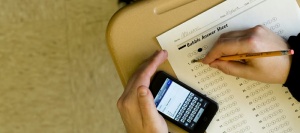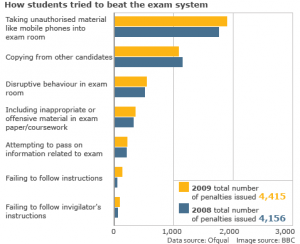Cheating Technologies
Cheating Technologies are a variety of means of plagiarizing online. Plagiarism is the act of presenting someone else’s ideas or work as your own, without attribution.[1] The integration of technology in classroom settings and homework assignments is assisting in growing the plagiarism epidemic. As endless amounts of information are at students disposal, the temptation to cheat is getting harder to resist. The creation of websites where you can pay money for term papers or enter chat rooms with others to swap science projects or math test answers[2] only adds to this issue, and leaves students with little reason to resist. Nonetheless, a technological revolution is underway, and as the world moves in that direction, educators must evolve as well to avoid academic dishonesty.
Contents
“Cybercheating” in Academics
Case Study
Andersen Davis conducted a study to measure how the ease of use of an information system predicts behavior later on.[4] The study conducted surveyed college students to see how their own ethical ideas and principles related to their opinions on acts of plagiarism. They were asked questions like how do students currently use information technology in an academically dishonest way, and how do you perceive other students when you catch them in an act of cheating? They listed the top 24 descriptions of academically dishonest behavior, and voted on them on a scale (1-5). Here is what the students believed the top five unethical behaviors using information technology were:
- Buying a paper online and submitting it as your own
- Copying and pasting an essay from the Internet and submitting it as your own
- Copying a file on a disk containing a complete assignment from a friend and submitting the work with your name
- Copying a friend’s file from a disk, replacing his name with yours and submitting as your own work if the assigned material is something that you already know well
- Claiming to have attached an assignment to an e-mail when you did not in order to have extra time to complete the work
While these students understood that these were morally wrong, as do most students, many still conducted these acts in desperate times. We must understand where the idea that “cheating is okay” stems from.
Cramster, Course Hero and SparkNotes
Historically, college students might turn to classmates for help during preparation for exams or when trying to complete assignments. However, now more and more students are relying on commercial websites with step-by-step solutions to textbook problems, copies of previous exams, lecture notes, summaries of literary classics, as well as real-time help from tutors that are able to teach physics, math and computer science. Students have their own reasons for justifying their use of such websites. “It’s a backup,” claims Chris O’Connor, a pre-med sophomore at Columbia University who relies on Cramster for help with math and science problems. O’Connor elaborates, “Many professors who return homework won’t tell you how you got it wrong – just that it’s wrong. This way you can complete the feedback process, which is essential to learning.” However, as companies such as Cramster, Course Hero and SparkNotes are completely transforming the way undergraduate students such as O’Connor study, many professors are questioning the ethics behind whether such websites encourage cheating and undermine the mental sweat equity and grit needed in day-to-day learning by alluring students with complete step-by-step solutions to their problems. [5]
Three-Layer Issue
Students
Children are starting to cheat at younger age. In elementary school, where they will steal pokemon cards, or use their cell phone to take pictures of their teacher during class, children misuse the technological devices they are given before they realize the consequences[1]. By the time students are in middle and high school, cheating is a normal part of their education. What has made this so easy, though, is technology. Now, 10-40% of high school students admitted to knowing other students who had used the Internet to cheat, many times plagiarizing papers, and 30% of college students write their papers without properly citing the information they obtained online.[4] When working on a project, the students do not understand where the line crosses from teamwork to cheating, and as colleges get harder to be accepted into, the pressure is rising and beginning to start at an even earlier age.[6] Many students claim there just are not enough hours in the day to get the amount of work they are assigned done and up to a high standard.[7]Teachers and Parents
As top colleges have decreasing acceptance rates, parents project loads of high expectations and immense pressure on their children. 1 in 4 adults believes he has to cheat and lie in order to get ahead in life, and from their own experience succeeding this way, communicate this mentality to children.[2] This takes the love out of learning, though. It is shown that when students really care about learning and the subjects they are being taught, they are less likely to cheat. As learning becomes a competition only, the cheating is increasing. 60% of high-achieving high schoolers admitted to having cheated at least once and half of them said they did not believe cheating was wrong.[2] As the parents set unreachable standards for their children, teachers assign impossible amounts of work.[6] The accessibility of computers and the Internet has made it tempting to cheat, since it is easy and quick. In addition, there is a growing gap between the technological knowledge these teachers and technology-savvy students know.[1] This allows the students to believe they can get away with it, increasing the presence of plagiarism. 95 percent of cheaters said they have never been caught, and 90% of college students believe these cheaters will never be punished for it.[2] Technologies have been invented for teachers to utilize when students hand in a paper in order to catch the plagiarism. There are three categories of techniques teachers can deploy to conquer plagiarism:[1]
- The application of commercial, technology-based tools for delecting plagiarized schoolwork
- The establishment of academic policies for reducing cheating behaviors
- The re-evaluation and redesign of traditional methods of educational assessment
So far, though, these have not worked. Teachers have been reluctant to use technology-based tools in order to catch this form of cheating because they believe it instills a sense of mistrust in the students. Even when the students are caught, though, the teacher does not jump at the chance to punish the students, usually because of the unclear school policies.
Schools and Boards of Education
Schools and Boards of Education have not set clear enough rules pertaining to plagiarism, what it is, and how it should be taken care of if it does occur. The students do not know exactly what constitutes as plagiarism, and without this defined line, cheating becomes more prevalent.[4] With the integration of technology in education, the rules must be redetermined in order to accommodate online cheating. Due to the lack of clear-cut definitions, teachers do not feel comfortable getting students in trouble when they are caught cheating. There is a reluctance to take any large measures, typically due to the schools lack of clear directives on how to handle these situations.[1] Since there is a large spectrum of actions that fall under “cheating,” punishments need to be laid out accordingly and broadcasted throughout all aspects of the education system, so no teacher, administrator, parent, or student is confused on how these issues are going to be handled.
Ethics Surrounding Cheating Technologies
Cheating
Before an individual cheats, they are often torn between the motivation to gain an advantage from the cheating and the motivation to maintain a self-concept as honest[8] For example, if people used the internet to plagiarize an essay, then they would possibly receive a good grade on their assignment, but have to internally accept that they did not honestly earn it. According to Nina Mazar, every person holds a range of capabilities in terms of being dishonest and acting on cheating. Although these behaviors would normally be considered dishonest, people do not normally let it change their perception of themselves as honest[8]. This can be attributed to two theories: categorization and Attention to one’s own ethical standards.
Categorization
This theory suggests that whoever is acting dishonestly is able to categorize their action into a more plausible and upright action, therefore undermining how unethical the action could be considered[8]. This is in an attempt to rationalize the dishonest action. An example of this is outlined by Stephanie Etter. She explains that people are often opposed to doing things that will harm others, however, in the case of plagiarism, there is not necessarily direct physical or mental harm being done.[9]
Attention to Standards
This theory is regarding how much individuals pay attention to their own moral actions. According to the theory, Individuals who are more mindful of their standards of conduct are more likely to not cheat, since this would have a negative impact on their moral concept of themselves and Individuals who are not as mindful of their own standards of conduct are more likely to cheat because they do not evaluate their actions on a moral scale. In other words, they view an action that could be considered dishonest as more of a general action and one that is not linked to moral behavior[8].
Ghost Writing
Ghost writing is the practice in which someone writes for you with the knowledge that it is not going to be recognized as their own work. This is done frequently in politics. Students have recently taken this idea and applied it to themselves, wondering why it is considered morally justified for politicians to take other's words and pass them off as their own, but not okay for themselves to do the same. [10]
References
- ↑ 1.0 1.1 1.2 1.3 1.4 Conradson, S. & Hernández-Ramos, P. (2004). Computers, the internet, and cheating among secondary school students: Some implications for educators. Practical Assessment, Research, and Evaluation 9(9). [Available online http://pareonline.net/getvn.asp?v=9&n=9.]
- ↑ 2.0 2.1 2.2 2.3 2.4 Kleiner, Carolyn, and Mary Lord. “The Cheating Game.” U.S. News & World Report, 22 Nov. 1999, www.geocities.ws/greenjellico/Work/English152/TheCheatingGame.pdf.
- ↑ Ma, Hongyan Jane, et al. “Digital Cheating and Plagiarism in Schools.” Theory Into Practice, vol. 47, no. 3, 2008, pp. 197–203., doi:10.1080/00405840802153809.
- ↑ 4.0 4.1 4.2 Stephanie Etter, Jackie J. Cramer & Seth Finn (2006) Origins of Academic Dishonesty, Journal of Research on Technology in Education, 39:2, 133-155, DOI: 10.1080/15391523.2006.10782477
- ↑ Foderaro, L. W. (2009, May 18). Psst! Need the Answer to No. 7? Click Here. Retrieved from https://www.nytimes.com/2009/05/18/education/18cram.html
- ↑ 6.0 6.1 McCabe, D. L. (1999). Academic dishonesty among high school students.Adolescence, 34(136), 681-7. Retrieved from https://search.proquest.com/docview/195939642?accountid=35396
- ↑ Kleiner, Carolyn, and Mary Lord. “Evering, Lea Calvert, and Gary Moorman. “Rethinking Plagiarism in the Digital Age.” Journal of Adolescent & Adult Literacy, vol. 56, no. 1, 2012, pp. 35–44., doi:10.1002/jaal.00100.
- ↑ 8.0 8.1 8.2 8.3 Mazar, Nina, et al. “The Dishonesty of Honest People”. Journal of Marketing Research, Vol. 5. December 2008.
- ↑ Etter, Stephanie, et. al. "Origins of Academic Dishonesty: Ethical Orientations and Personality Factors Associated with Attitudes about Cheating with Information Technology" Journal of Research on Technology in Education. 2006-2007.
- ↑ Snapper, John. "The Matter of Plagiarism: What, Why, and If" The Handbook of Information and Computer Ethics. 2008.

